外研版英语必修3同步教学课件:Module 1 Europe Section Ⅱ Grammar
文档属性
| 名称 | 外研版英语必修3同步教学课件:Module 1 Europe Section Ⅱ Grammar | 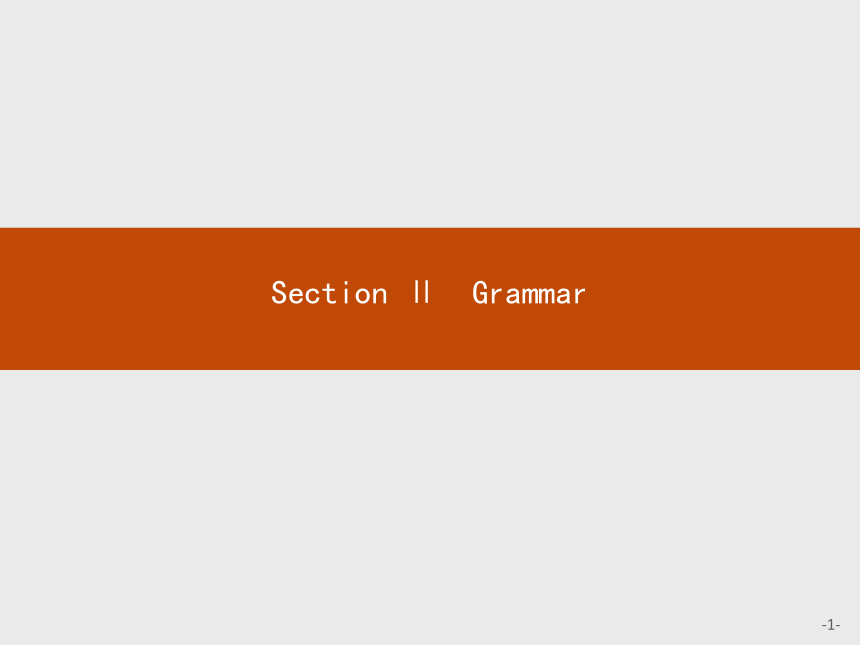 | |
| 格式 | zip | ||
| 文件大小 | 279.7KB | ||
| 资源类型 | 教案 | ||
| 版本资源 | 外研版 | ||
| 科目 | 英语 | ||
| 更新时间 | 2017-01-01 21:41:34 | ||
图片预览

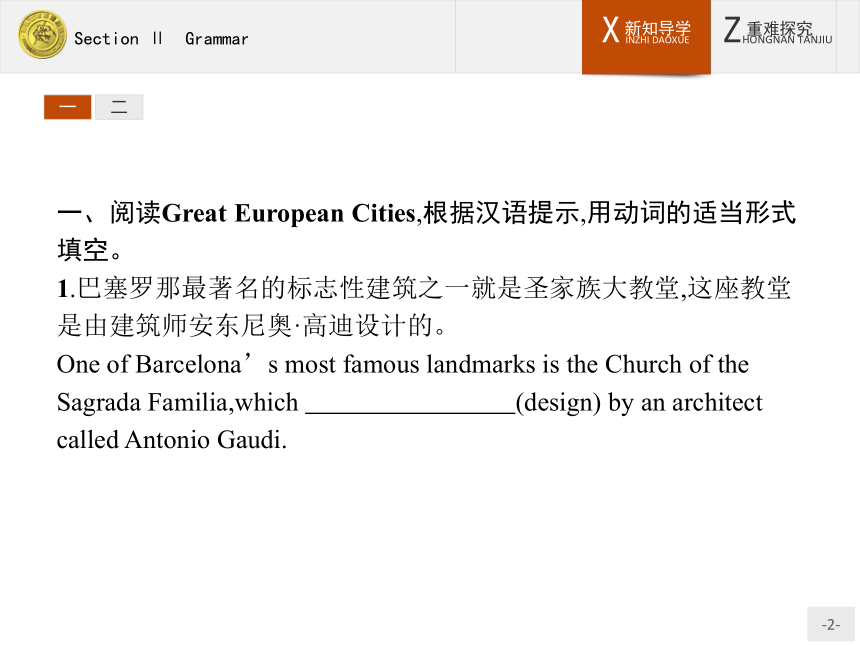
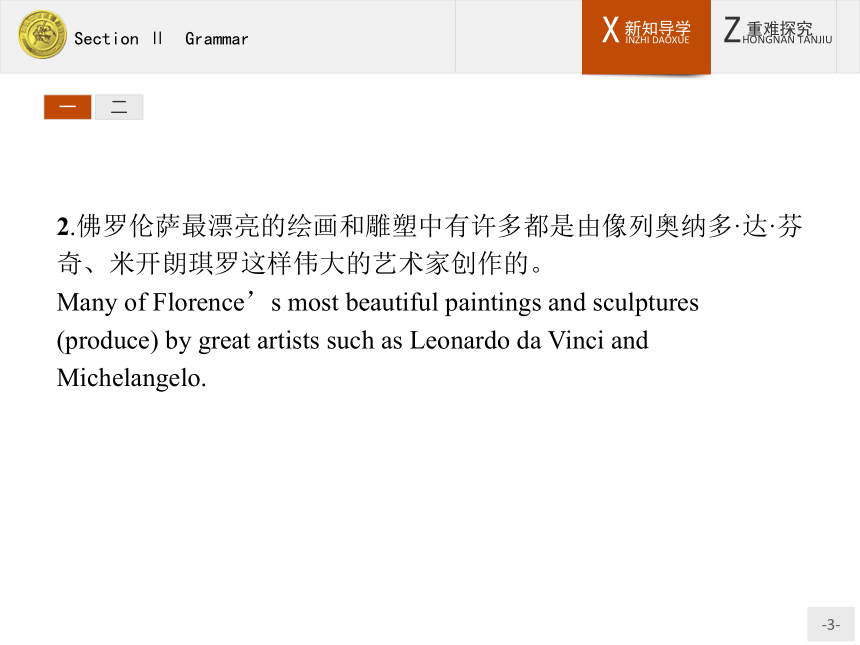
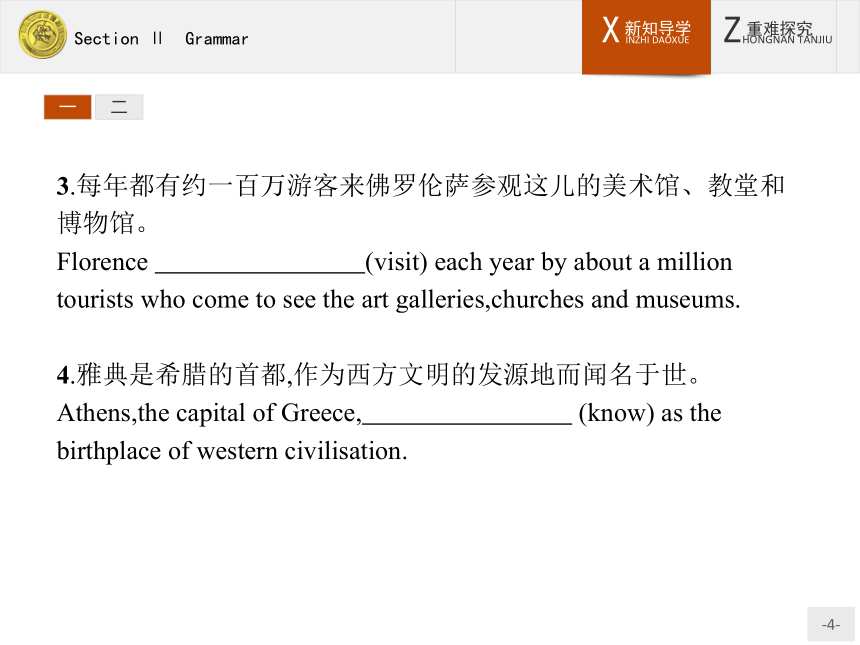
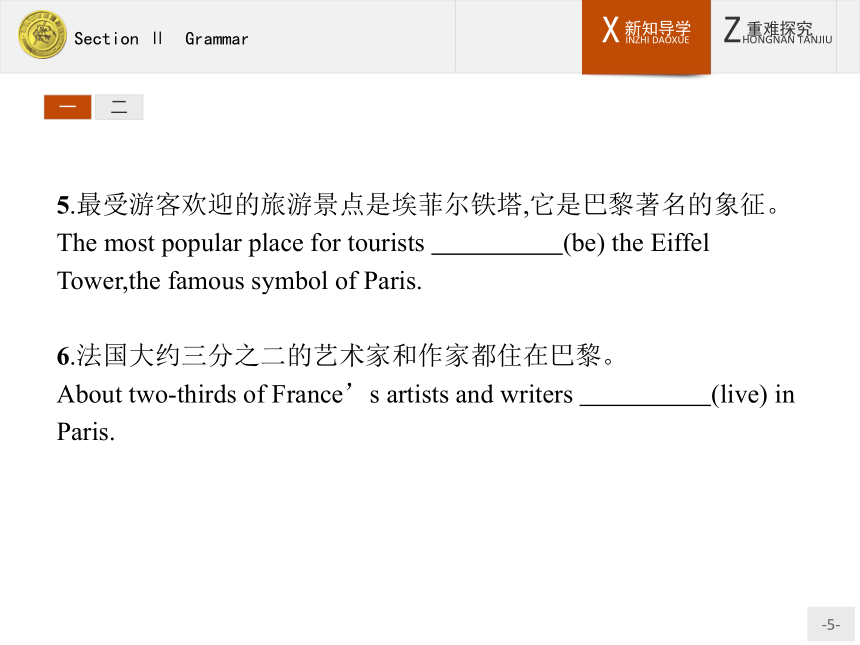
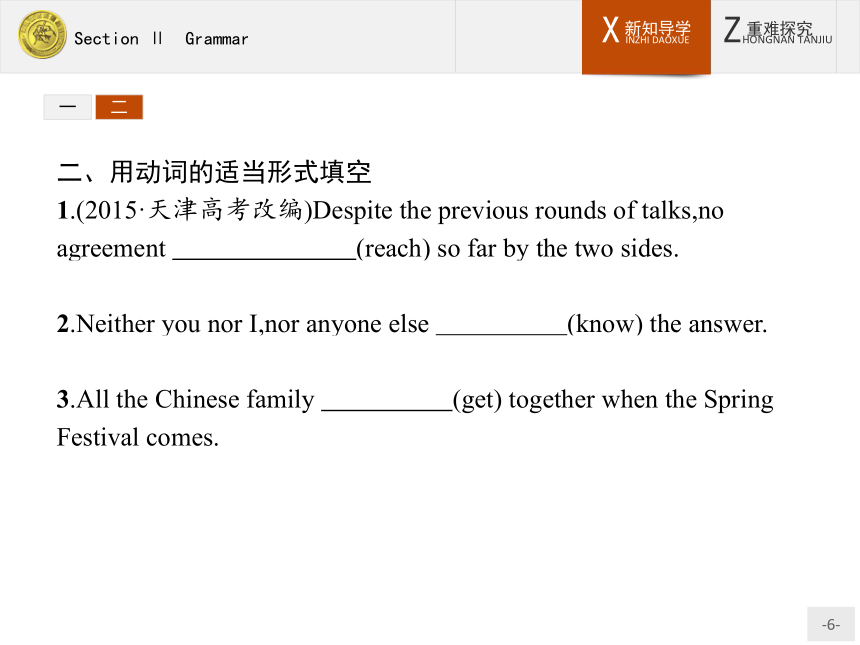


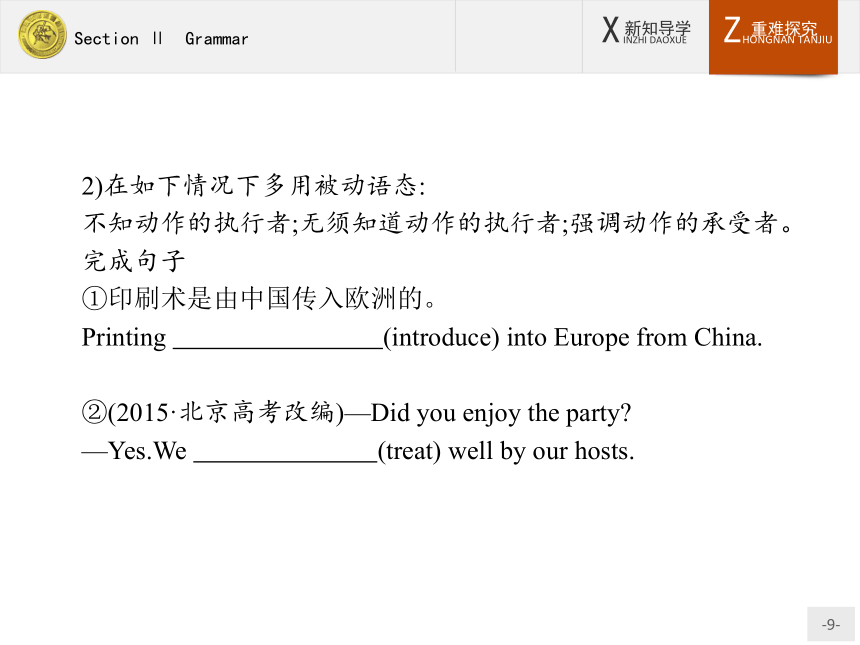
文档简介
课件28张PPT。Section Ⅱ Grammar一二一、阅读Great European Cities,根据汉语提示,用动词的适当形式填空。
1.巴塞罗那最著名的标志性建筑之一就是圣家族大教堂,这座教堂是由建筑师安东尼奥·高迪设计的。
One of Barcelona’s most famous landmarks is the Church of the Sagrada Familia,which (design) by an architect called Antonio Gaudi.?
答案:was designed一二2.佛罗伦萨最漂亮的绘画和雕塑中有许多都是由像列奥纳多·达·芬奇、米开朗琪罗这样伟大的艺术家创作的。
Many of Florence’s most beautiful paintings and sculptures (produce) by great artists such as Leonardo da Vinci and Michelangelo.?
答案:were produced一二3.每年都有约一百万游客来佛罗伦萨参观这儿的美术馆、教堂和博物馆。
Florence (visit) each year by about a million tourists who come to see the art galleries,churches and museums.?
答案:is visited
4.雅典是希腊的首都,作为西方文明的发源地而闻名于世。
Athens,the capital of Greece, (know) as the birthplace of western civilisation.?
答案:is known一二5.最受游客欢迎的旅游景点是埃菲尔铁塔,它是巴黎著名的象征。
The most popular place for tourists (be) the Eiffel Tower,the famous symbol of Paris.?
答案:is
6.法国大约三分之二的艺术家和作家都住在巴黎。
About two-thirds of France’s artists and writers (live) in Paris.?
答案:live一二二、用动词的适当形式填空
1.(2015·天津高考改编)Despite the previous rounds of talks,no agreement (reach) so far by the two sides.?
答案:has been reached
2.Neither you nor I,nor anyone else (know) the answer.?
答案:knows
3.All the Chinese family (get) together when the Spring Festival comes.?
答案:get一二4.Many a boy and many a girl (have) made the same mistake.?
答案:has
5.He is one of the students who (praise) at the meeting held last week.?
答案:were praised被动语态和主谓一致
★考点一:一般现在时和一般过去时的被动语态
1)被动语态
英语的语态是通过动词形式的变化表现出来的。英语中有两种语态:主动语态和被动语态。主动语态表示主语是动作的执行者;被动语态表示主语是动作的承受者,即行为动作的对象。
①Many people speak Chinese.
这个句子中谓语speak的动作是由主语many people来执行的。
②Chinese is spoken by many people.
这个句子中Chinese是动词speak的承受者。2)在如下情况下多用被动语态:
不知动作的执行者;无须知道动作的执行者;强调动作的承受者。
完成句子
①印刷术是由中国传入欧洲的。
Printing (introduce) into Europe from China.?
答案:was introduced
②(2015·北京高考改编)—Did you enjoy the party?
—Yes.We (treat) well by our hosts.?
答案:were treated3)主动语态变被动语态时的注意事项。
(1)若宾语补足语是不带to 的不定式,变为被动语态时,该不定式前要加“to”,此类动词为感官动词(feel,hear,listen to,look at,observe,see,notice及watch)或使役动词(make/have/let)。
(2)若主动语态谓语动词中含情态动词,由“情态动词+ be +过去分词”构成被动语态。
(3)谓语为及物动词短语的主动语态变为被动语态时,要保留介词。
(4)接双宾语的动词改为被动语态时,通常将间接宾语改为主语;当用直接宾语(物)做主语时,动词后要用介词,这个介词是由与其搭配的动词决定的。把下列句子变成被动语态
①We saw him play football on the playground.
→He was seen (play) football on the playground.?
答案:to play
②We can’t laugh at him.
→He can’t (laugh) at by us.?
答案:be laughed
③They take good care of children in this kindergarten.
→Children in this kindergarten (take) good care of by them.?
答案:are taken④We agree that the human eyes can tell 10 million different colours.
→It that the human eyes can tell 10 million different colours.?
答案:is agreed
⑤His mother gave him a present for his birthday.
→He (give) a present by his mother for his birthday.?
答案:was given
⑥I offered him a house for 1,000 pounds.
→A house (offer) to him (by me) for 1,000 pounds.?
答案:was offered4)常用主动形式表示被动的几种情况:
(1)表示开始、结束和开关意义的一类动词,如:start,begin,end,stop,finish,open,close等。
(2)表示主语状态和特征的系动词后接形容词做表语时,用主动形式表示被动。如look,smell,sound,taste,feel等。
(3)表示主语状态和特征的某些动词后接副词做程度状语时,用主动形式表示被动。常见的此类动词有read,write,sell,keep,show,clean,wash,wear,move,drive,operate等。
(4)在need,require,want,worth (形容词),deserve后接动词-ing形式时,用主动形式表示被动。
(5)由blame,let(出租)等构成不定式做表语时,用主动形式表示被动。
(6)不定式跟在形容词(difficult,hard,fit,easy,impossible,dangerous等)后做状语时,用主动形式表示被动。完成句子
①这家超市早上开门早晚上关门晚。
The supermarket (open) early in the morning and (close) late in the evening.?
答案:opens;closes
②这则消息听起来很鼓舞人,但是我们并没有受到鼓舞。
This news (sound) encouraging,but we are not encouraged.?
答案:sounds
③他的书销路很好。
His books (sell) quite well.?
答案:sell④这本书非常值得一读。
The book is well worth (read).?
答案:reading
⑤父亲应对惯坏的孩子负责。
The father was (blame) for the spoiled boy.?
答案:to blame
⑥The air here is fresh (breathe).?
答案:to breathe★考点二:主谓一致
1)当主语由and连接时,如果它表示一个单一的概念,谓语动词用单数;表示多个概念,谓语动词用复数。
语法填空
A teacher and a writer (be) present at the meeting.?
一位教师和一位作家出席了这次会议。
答案:were
2)the rest of/half of修饰名词做主语时,谓语动词与名词的人称和数保持一致。
语法填空
The rest of the boys (start) to jump and sing happily and noisily.?
其余的男孩开始高兴地、喧闹地又唱又跳起来。
答案:were starting3)集合名词(enemy/army/class/team/family/couple/police等)被视为一个整体时,谓语动词用单数;强调若干个体时,谓语动词用复数。
语法填空
The young couple always (quarrel) with each other about money.?
这对年轻夫妇总是为花钱而吵架。
答案:are;quarrelling
4)表示金钱、时间、价格或度量衡的复数名词做主语时,通常把这些名词看作一个整体,谓语一般用单数。
语法填空
Three years (be) a long time.?
三年的时间很长。
答案:is5)当主语后面跟有with,together with,like,except,but,no less than,as well as,like,rather than等词连接的短语时,谓语动词与前面的主语的数一致。
语法填空
They,together with my father, (go) to Beijing already.?
他们和我父亲已经一起去北京了。
答案:have gone6)在一些短语如 many a 或 more than one等所修饰的名词做主语时,谓语动词多用单数形式;但由more than...of 做主语时,动词应与其后的名词或代词保持一致。
语法填空
①More than one student punished just because of breaking the school rules.?
不止一个学生因为违反学校规定而受到惩罚。
②More than 60 percent of the workers (be) from the countryside.?
百分之六十多的工人都来自农村。
答案:①was ②are7)every...and every...,each...and each...,many a...and many a...,no...and no...等修饰单数名词,谓语动词用单数。
语法填空
Each boy and each girl (wish) to attend the party.?
每个男孩和女孩都希望参加这个聚会。
答案:wishes
8)由两部分构成的物体(如trousers,shoes,pants,shorts,glasses,compasses等),这样的名词做主语时,谓语动词用复数;但如果这类名词前由a pair of/pairs of修饰,谓语动词形式取决于pair的单复数。
语法填空
This pair of trousers (be) too long for you.?
这条裤子对你来说太长了。
答案:is9)分数和百分数修饰可数名词或不可数名词做主语时,谓语动词的形式取决于名词的单复数。
语法填空
About 70 percent of the surface of the earth (be) covered with water.?
地球表面大约有70%的地方由水覆盖。
答案:is
10)由kind,form,type,sort,species,portion,series,amount等修饰名词做主语,其谓语动词的形式通常取决于这些词的单复数。
语法填空
All kinds of difficulties (have) to be overcome.?
必须克服各种各样的困难。
答案:have
11)“a+单数名词+or two”做主语,谓语动词用单数;“one or two + 名词复数”做主语,谓语动词用复数。
语法填空
A student or two or three (allow) here,and one or two reasons (suggest).?
允许一两名、两三名学生在这里,并且提出了一两条理由。
答案:was allowed;were suggested
12)there be句型的主语有两个以上,谓语动词与邻近的主语一致。
语法填空
There (be)an old pine tree and three willow trees in front of the house.?
房子前面有一棵老松树和三棵柳树。
答案:is
13)当either...or...;not only...but also...与neither...nor...,not...but...连接两个主语时,谓语动词与最邻近的主语保持一致。如果句子由here,there引导,而主语又不止一个时,谓语通常也和最邻近的主语一致。
语法填空
(have) either you or he been to the library??
你或者他去过图书馆吗?
答案:Have
14)what引导的主语从句,谓语动词多用单数;但当从句中含有附属意义的并列结构或表语是复数名词时,谓语动词用复数。
语法填空
What we need (be)effective measures to solve the problem.?
我们所需要的是解决这个问题的有效措施。
答案:are15)“one of+复数名词+who/which/that”型定语从句,先行词为复数名词,从句的谓语动词用复数;“the only(very/right) one of + 复数名词+ who/which/that”型定语从句,先行词为one,从句的谓语动词用单数。
语法填空
Li Ming is one of the students who (be) a winner of the scholarship.?
李明是他班里获得奖学金的学生之一。
答案:are16)强调句强调主语时,that/who后谓语动词与句子的主语一致。
语法填空
It is you,rather than he,that (be) to blame for the accident.?
是你而不是他应对事故负责。
答案:are
17)先行词为人称代词,定语从句中关系代词做主语时,定语从句的谓语动词与句子的主语一致。
语法填空
I,who (be) your brother,will try my best to help you with your study.?
作为你的哥哥,我会尽全力帮助你好好学习。
答案:am18)倒装句中,谓语动词与句子的主语一致。
语法填空
On each side of the street (stand) tall buildings.?
街道的两侧高楼林立。
答案:stand答案:1)was chosen 2)is;takes 3)(2015·四川高考改编)More expressways (build) in Sichuan soon to promote the local economy.?
4)Mr Brown is the only one of the few persons I know who (have) been abroad.?
5)The little boy was made (cry) by his brother.?
6)(2015·湖南高考改编)I had a strong desire to reach in and play with the toy,but (hold) back thankfully by the shop window.?答案: 3)will be built 4)has 5)to cry 6)was held
1.巴塞罗那最著名的标志性建筑之一就是圣家族大教堂,这座教堂是由建筑师安东尼奥·高迪设计的。
One of Barcelona’s most famous landmarks is the Church of the Sagrada Familia,which (design) by an architect called Antonio Gaudi.?
答案:was designed一二2.佛罗伦萨最漂亮的绘画和雕塑中有许多都是由像列奥纳多·达·芬奇、米开朗琪罗这样伟大的艺术家创作的。
Many of Florence’s most beautiful paintings and sculptures (produce) by great artists such as Leonardo da Vinci and Michelangelo.?
答案:were produced一二3.每年都有约一百万游客来佛罗伦萨参观这儿的美术馆、教堂和博物馆。
Florence (visit) each year by about a million tourists who come to see the art galleries,churches and museums.?
答案:is visited
4.雅典是希腊的首都,作为西方文明的发源地而闻名于世。
Athens,the capital of Greece, (know) as the birthplace of western civilisation.?
答案:is known一二5.最受游客欢迎的旅游景点是埃菲尔铁塔,它是巴黎著名的象征。
The most popular place for tourists (be) the Eiffel Tower,the famous symbol of Paris.?
答案:is
6.法国大约三分之二的艺术家和作家都住在巴黎。
About two-thirds of France’s artists and writers (live) in Paris.?
答案:live一二二、用动词的适当形式填空
1.(2015·天津高考改编)Despite the previous rounds of talks,no agreement (reach) so far by the two sides.?
答案:has been reached
2.Neither you nor I,nor anyone else (know) the answer.?
答案:knows
3.All the Chinese family (get) together when the Spring Festival comes.?
答案:get一二4.Many a boy and many a girl (have) made the same mistake.?
答案:has
5.He is one of the students who (praise) at the meeting held last week.?
答案:were praised被动语态和主谓一致
★考点一:一般现在时和一般过去时的被动语态
1)被动语态
英语的语态是通过动词形式的变化表现出来的。英语中有两种语态:主动语态和被动语态。主动语态表示主语是动作的执行者;被动语态表示主语是动作的承受者,即行为动作的对象。
①Many people speak Chinese.
这个句子中谓语speak的动作是由主语many people来执行的。
②Chinese is spoken by many people.
这个句子中Chinese是动词speak的承受者。2)在如下情况下多用被动语态:
不知动作的执行者;无须知道动作的执行者;强调动作的承受者。
完成句子
①印刷术是由中国传入欧洲的。
Printing (introduce) into Europe from China.?
答案:was introduced
②(2015·北京高考改编)—Did you enjoy the party?
—Yes.We (treat) well by our hosts.?
答案:were treated3)主动语态变被动语态时的注意事项。
(1)若宾语补足语是不带to 的不定式,变为被动语态时,该不定式前要加“to”,此类动词为感官动词(feel,hear,listen to,look at,observe,see,notice及watch)或使役动词(make/have/let)。
(2)若主动语态谓语动词中含情态动词,由“情态动词+ be +过去分词”构成被动语态。
(3)谓语为及物动词短语的主动语态变为被动语态时,要保留介词。
(4)接双宾语的动词改为被动语态时,通常将间接宾语改为主语;当用直接宾语(物)做主语时,动词后要用介词,这个介词是由与其搭配的动词决定的。把下列句子变成被动语态
①We saw him play football on the playground.
→He was seen (play) football on the playground.?
答案:to play
②We can’t laugh at him.
→He can’t (laugh) at by us.?
答案:be laughed
③They take good care of children in this kindergarten.
→Children in this kindergarten (take) good care of by them.?
答案:are taken④We agree that the human eyes can tell 10 million different colours.
→It that the human eyes can tell 10 million different colours.?
答案:is agreed
⑤His mother gave him a present for his birthday.
→He (give) a present by his mother for his birthday.?
答案:was given
⑥I offered him a house for 1,000 pounds.
→A house (offer) to him (by me) for 1,000 pounds.?
答案:was offered4)常用主动形式表示被动的几种情况:
(1)表示开始、结束和开关意义的一类动词,如:start,begin,end,stop,finish,open,close等。
(2)表示主语状态和特征的系动词后接形容词做表语时,用主动形式表示被动。如look,smell,sound,taste,feel等。
(3)表示主语状态和特征的某些动词后接副词做程度状语时,用主动形式表示被动。常见的此类动词有read,write,sell,keep,show,clean,wash,wear,move,drive,operate等。
(4)在need,require,want,worth (形容词),deserve后接动词-ing形式时,用主动形式表示被动。
(5)由blame,let(出租)等构成不定式做表语时,用主动形式表示被动。
(6)不定式跟在形容词(difficult,hard,fit,easy,impossible,dangerous等)后做状语时,用主动形式表示被动。完成句子
①这家超市早上开门早晚上关门晚。
The supermarket (open) early in the morning and (close) late in the evening.?
答案:opens;closes
②这则消息听起来很鼓舞人,但是我们并没有受到鼓舞。
This news (sound) encouraging,but we are not encouraged.?
答案:sounds
③他的书销路很好。
His books (sell) quite well.?
答案:sell④这本书非常值得一读。
The book is well worth (read).?
答案:reading
⑤父亲应对惯坏的孩子负责。
The father was (blame) for the spoiled boy.?
答案:to blame
⑥The air here is fresh (breathe).?
答案:to breathe★考点二:主谓一致
1)当主语由and连接时,如果它表示一个单一的概念,谓语动词用单数;表示多个概念,谓语动词用复数。
语法填空
A teacher and a writer (be) present at the meeting.?
一位教师和一位作家出席了这次会议。
答案:were
2)the rest of/half of修饰名词做主语时,谓语动词与名词的人称和数保持一致。
语法填空
The rest of the boys (start) to jump and sing happily and noisily.?
其余的男孩开始高兴地、喧闹地又唱又跳起来。
答案:were starting3)集合名词(enemy/army/class/team/family/couple/police等)被视为一个整体时,谓语动词用单数;强调若干个体时,谓语动词用复数。
语法填空
The young couple always (quarrel) with each other about money.?
这对年轻夫妇总是为花钱而吵架。
答案:are;quarrelling
4)表示金钱、时间、价格或度量衡的复数名词做主语时,通常把这些名词看作一个整体,谓语一般用单数。
语法填空
Three years (be) a long time.?
三年的时间很长。
答案:is5)当主语后面跟有with,together with,like,except,but,no less than,as well as,like,rather than等词连接的短语时,谓语动词与前面的主语的数一致。
语法填空
They,together with my father, (go) to Beijing already.?
他们和我父亲已经一起去北京了。
答案:have gone6)在一些短语如 many a 或 more than one等所修饰的名词做主语时,谓语动词多用单数形式;但由more than...of 做主语时,动词应与其后的名词或代词保持一致。
语法填空
①More than one student punished just because of breaking the school rules.?
不止一个学生因为违反学校规定而受到惩罚。
②More than 60 percent of the workers (be) from the countryside.?
百分之六十多的工人都来自农村。
答案:①was ②are7)every...and every...,each...and each...,many a...and many a...,no...and no...等修饰单数名词,谓语动词用单数。
语法填空
Each boy and each girl (wish) to attend the party.?
每个男孩和女孩都希望参加这个聚会。
答案:wishes
8)由两部分构成的物体(如trousers,shoes,pants,shorts,glasses,compasses等),这样的名词做主语时,谓语动词用复数;但如果这类名词前由a pair of/pairs of修饰,谓语动词形式取决于pair的单复数。
语法填空
This pair of trousers (be) too long for you.?
这条裤子对你来说太长了。
答案:is9)分数和百分数修饰可数名词或不可数名词做主语时,谓语动词的形式取决于名词的单复数。
语法填空
About 70 percent of the surface of the earth (be) covered with water.?
地球表面大约有70%的地方由水覆盖。
答案:is
10)由kind,form,type,sort,species,portion,series,amount等修饰名词做主语,其谓语动词的形式通常取决于这些词的单复数。
语法填空
All kinds of difficulties (have) to be overcome.?
必须克服各种各样的困难。
答案:have
11)“a+单数名词+or two”做主语,谓语动词用单数;“one or two + 名词复数”做主语,谓语动词用复数。
语法填空
A student or two or three (allow) here,and one or two reasons (suggest).?
允许一两名、两三名学生在这里,并且提出了一两条理由。
答案:was allowed;were suggested
12)there be句型的主语有两个以上,谓语动词与邻近的主语一致。
语法填空
There (be)an old pine tree and three willow trees in front of the house.?
房子前面有一棵老松树和三棵柳树。
答案:is
13)当either...or...;not only...but also...与neither...nor...,not...but...连接两个主语时,谓语动词与最邻近的主语保持一致。如果句子由here,there引导,而主语又不止一个时,谓语通常也和最邻近的主语一致。
语法填空
(have) either you or he been to the library??
你或者他去过图书馆吗?
答案:Have
14)what引导的主语从句,谓语动词多用单数;但当从句中含有附属意义的并列结构或表语是复数名词时,谓语动词用复数。
语法填空
What we need (be)effective measures to solve the problem.?
我们所需要的是解决这个问题的有效措施。
答案:are15)“one of+复数名词+who/which/that”型定语从句,先行词为复数名词,从句的谓语动词用复数;“the only(very/right) one of + 复数名词+ who/which/that”型定语从句,先行词为one,从句的谓语动词用单数。
语法填空
Li Ming is one of the students who (be) a winner of the scholarship.?
李明是他班里获得奖学金的学生之一。
答案:are16)强调句强调主语时,that/who后谓语动词与句子的主语一致。
语法填空
It is you,rather than he,that (be) to blame for the accident.?
是你而不是他应对事故负责。
答案:are
17)先行词为人称代词,定语从句中关系代词做主语时,定语从句的谓语动词与句子的主语一致。
语法填空
I,who (be) your brother,will try my best to help you with your study.?
作为你的哥哥,我会尽全力帮助你好好学习。
答案:am18)倒装句中,谓语动词与句子的主语一致。
语法填空
On each side of the street (stand) tall buildings.?
街道的两侧高楼林立。
答案:stand答案:1)was chosen 2)is;takes 3)(2015·四川高考改编)More expressways (build) in Sichuan soon to promote the local economy.?
4)Mr Brown is the only one of the few persons I know who (have) been abroad.?
5)The little boy was made (cry) by his brother.?
6)(2015·湖南高考改编)I had a strong desire to reach in and play with the toy,but (hold) back thankfully by the shop window.?答案: 3)will be built 4)has 5)to cry 6)was held
